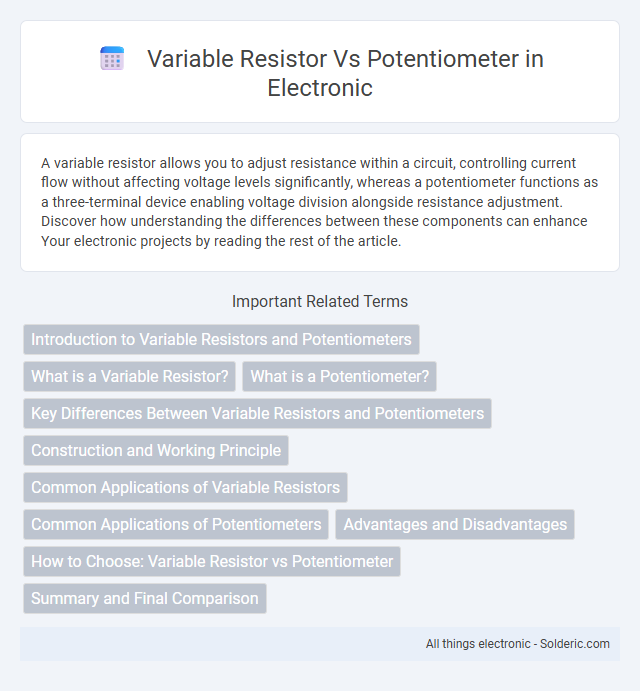A variable resistor allows you to adjust resistance within a circuit, controlling current flow without affecting voltage levels significantly, whereas a potentiometer functions as a three-terminal device enabling voltage division alongside resistance adjustment. Discover how understanding the differences between these components can enhance Your electronic projects by reading the rest of the article.
Comparison Table
| Feature | Variable Resistor | Potentiometer |
|---|---|---|
| Definition | Resistor with adjustable resistance. | Three-terminal resistor used as voltage divider with adjustable output. |
| Number of Terminals | Two terminals. | Three terminals. |
| Function | Adjust current flow by varying resistance. | Adjust voltage output by dividing input voltage. |
| Common Use | Current control in circuits. | Voltage control and signal adjustment. |
| Connection | Connected in series with circuit. | Connected as voltage divider or adjustable voltage source. |
| Output | Variable resistance only. | Variable voltage output. |
| Typical Applications | Volume control, light dimming (less common). | Volume control, tuning, calibration. |
Introduction to Variable Resistors and Potentiometers
Variable resistors and potentiometers are essential components in electronic circuits used to adjust resistance values. A variable resistor changes resistance between two terminals while a potentiometer offers a three-terminal design to function as an adjustable voltage divider. Both devices enable precise control of electrical current and voltage, making them vital for tuning and calibration tasks in electronics.
What is a Variable Resistor?
A variable resistor is an electronic component that allows the resistance to be manually adjusted, controlling the current flow within a circuit. Unlike fixed resistors, variable resistors provide flexible resistance values through a movable contact along a resistive element. Common types include rheostats and potentiometers, both widely used for tuning and calibration in electronic devices.
What is a Potentiometer?
A potentiometer is a three-terminal variable resistor used to adjust voltage levels by varying resistance within an electrical circuit. Unlike a simple variable resistor, which typically has two terminals and controls current flow, a potentiometer serves as a voltage divider, allowing precise control over output voltage. Your choice of a potentiometer enables fine-tuning of parameters in applications like audio controls, dimming lights, or calibrating sensors.
Key Differences Between Variable Resistors and Potentiometers
Variable resistors control current flow by adjusting resistance in a circuit without creating a voltage divider, while potentiometers function as adjustable voltage dividers with three terminals. Variable resistors typically have two terminals and are used for tuning and calibration, whereas potentiometers have three terminals and provide a user-adjustable output voltage. The key difference lies in their application: variable resistors manage current levels, and potentiometers adjust signal voltage or serve as input devices like volume controls.
Construction and Working Principle
A variable resistor consists of a resistive element and a sliding contact (wiper) that moves along the element to adjust resistance, typically featuring two terminals for current flow control. A potentiometer, also built with a resistive track and a wiper, includes three terminals, enabling it to function as a voltage divider by tapping a variable voltage output from the resistive element. Both devices operate by changing the position of the wiper along the resistive element, altering resistance or voltage division, but potentiometers provide more versatile control in circuits due to their three-terminal design.
Common Applications of Variable Resistors
Variable resistors and potentiometers are essential components in electronic circuits, used to adjust voltage and current levels. Common applications include volume control in audio equipment, tuning circuits in radios, and adjusting light intensity in dimmer switches. Your ability to fine-tune these parameters makes them invaluable for precise control in various devices and systems.
Common Applications of Potentiometers
Potentiometers are commonly used in volume controls, adjusting light intensity in dimmer switches, and serving as position sensors in joysticks or control panels. These devices provide precise control of electrical signals by varying resistance, making them suitable for tuning circuits and calibrating instruments. Your projects can benefit from potentiometers when you need smooth, adjustable control over voltage or signal input.
Advantages and Disadvantages
Variable resistors offer precise resistance adjustment with simple design and durability but lack a defined output voltage tapping point, limiting their use in voltage divider applications. Potentiometers provide versatile voltage control and easy signal tuning through a three-terminal configuration but can be less durable due to mechanical wear and may introduce noise in sensitive circuits. Selecting between the two depends on application-specific requirements for voltage division, resistance adjustment, and mechanical reliability.
How to Choose: Variable Resistor vs Potentiometer
Choosing between a variable resistor and a potentiometer depends on the application requirements such as voltage control, adjustment precision, and circuit integration. Variable resistors, often used for simple resistance adjustment in power circuits, provide single-terminal resistance changes, while potentiometers offer three terminals enabling voltage division for tuning audio levels, sensor calibration, or user interface controls. Selecting the appropriate device requires evaluating factors like desired adjustment range, electrical load, and whether a voltage output or resistance change is needed.
Summary and Final Comparison
A variable resistor adjusts resistance within a circuit to control current flow, typically offering a simple two-terminal design, while a potentiometer functions as a three-terminal device that provides adjustable voltage division. Your choice depends on whether you need precise voltage control or straightforward resistance adjustments. Variable resistors suit applications like dimming lights, whereas potentiometers excel in tuning circuits and user input devices.
Variable resistor vs potentiometer Infographic

 solderic.com
solderic.com